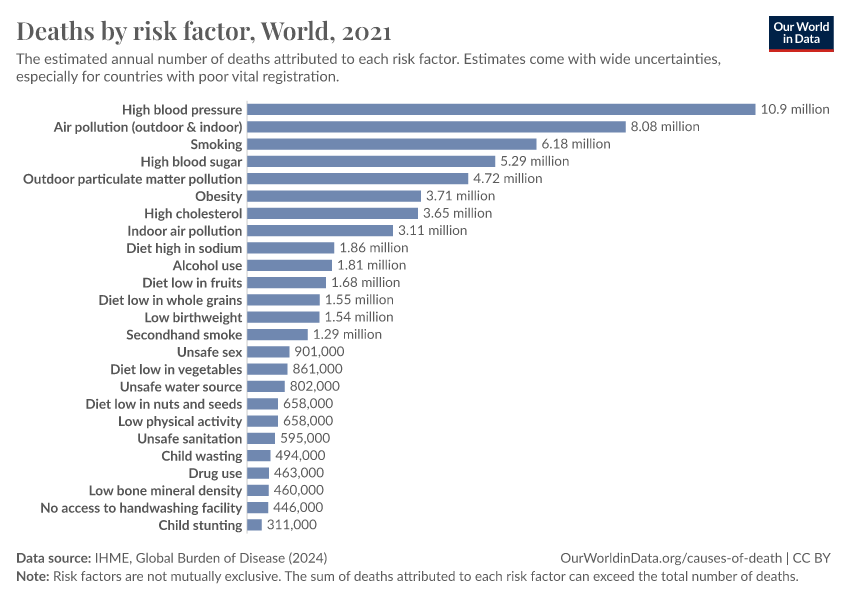Hygiene and Handwashing
How many people lack access to basic handwashing facilities?
Having access to basic handwashing facilities is important to reduce the spread of infectious diseases and pathogens.
However, more than 20% of the world’s population does not have access to basic handwashing facilities. That is, handwashing facilities with soap and water.
This is a major health risk. Lack of access to basic hygiene facilities is responsible for hundreds of thousands of deaths each year.
In this article, we give an overview of global and national data on access to basic hygiene facilities and its impact on health outcomes.
Lack of access to handwashing facilities is a large risk factor for death
Lack of access to handwashing facilities is responsible for more than half a million deaths each year
Having no access to basic handwashing facilities is a large health and environmental problem – particularly for the poorest in the world.
The Global Burden of Disease is a major global study on the causes and risk factors for death and disease published in the medical journal The Lancet.
These estimates of the annual number of deaths attributed to a wide range of risk factors are shown here.
In the chart, we see that it ranks as a very important risk factor for death globally.
According to the Global Burden of Disease study, more than half a million people die as a result of having no access to handwashing facilities every year. To put this into context, this is more than the annual number of homicides.
Death rates are much higher in low-income countries
Death rates from a lack of access to handwashing facilities give us an accurate comparison of differences in mortality impacts between countries and over time.
In this map, we see death rates from having no access to handwashing facilities across the world. Death rates measure the number of deaths per 100,000 people in a given country or region.
What becomes clear is the large differences in death rates between countries: rates are high in lower-income countries, particularly across Sub-Saharan Africa and Asia.
The issue of handwashing access is one that is largely limited to low- and lower-middle-income countries.
Access to handwashing facilities
What share of people do not have access to basic handwashing?
Approximately one-third of the world does not have access to basic handwashing facilities.
Hygiene and handwashing are included in SDG Target 6.2, to: “achieve access to adequate and equitable sanitation and hygiene for all and end open defecation” by 2030.
In recent years, around three-quarters of the world's population has had access to basic handwashing facilities. That means about one-quarter had to rely on washing facilities without soap and/or water or no handwashing facilities at all.
In the map, we see the share of people across the world who have access to basic handwashing facilities. In countries in Sub-Saharan Africa, typically, less than half of the population has access to facilities with soap and water.
The world is making progress on this problem. Access to basic handwashing facilities has gradually been increasing for the global population. But to achieve universal handwashing by 2030, this progress needs to go much faster.
How many people do not have access to basic handwashing?
In the map shown, we see the number of people across the world who do not have access to basic handwashing facilities.
Cite this work
Our articles and data visualizations rely on work from many different people and organizations. When citing this article, please also cite the underlying data sources. This article can be cited as:
Hannah Ritchie, Fiona Spooner, and Max Roser (2021) - “Hygiene and Handwashing” Published online at OurWorldinData.org. Retrieved from: 'https://ourworldindata.org/hygiene' [Online Resource]BibTeX citation
@article{owid-hygiene,
author = {Hannah Ritchie and Fiona Spooner and Max Roser},
title = {Hygiene and Handwashing},
journal = {Our World in Data},
year = {2021},
note = {https://ourworldindata.org/hygiene}
}Reuse this work freely
All visualizations, data, and code produced by Our World in Data are completely open access under the Creative Commons BY license. You have the permission to use, distribute, and reproduce these in any medium, provided the source and authors are credited.
The data produced by third parties and made available by Our World in Data is subject to the license terms from the original third-party authors. We will always indicate the original source of the data in our documentation, so you should always check the license of any such third-party data before use and redistribution.
All of our charts can be embedded in any site.





